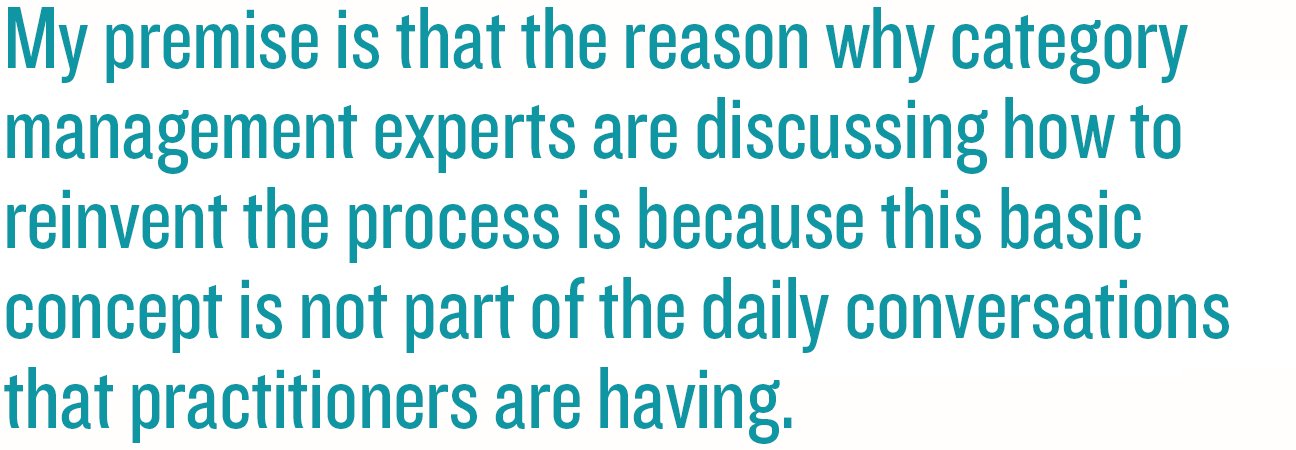
A great discussion was started on Retail Wire in early August about “reinventing” category management. Graeme McVie offers an excellent and very Middlegame-oriented introduction of how category management should be used:
An example of how category management 2.0 works can be seen in the bottled water segment, where consumers see little variation among different brands and 12-pack and 24-pack sizes take up large amounts of shelf space. Armed with shopper-level data about product preferences, retailers can be confident customers will switch their bottled water purchase to the available brands/sizes without being disappointed. With that additional “real estate,” they can expand their assortment to include more facings of healthy lifestyle beverages, which offer greater opportunities for high-margin sales.
Wow! This is terrific. We obviously talk about incrementality and transferred demand versus switching, but all of the right elements are there … using assortment analytics to cross-sell or upsell shoppers in a win fashion. The shopper wins since they have more choices that are relevant. The manufacturer wins since this means more opportunities to sell products. The retailer wins since the mix of SKUs is higher margin relative to the space allocated.
Sadly, this introduction is the last place in the conversation among the retail experts where anything like incrementality and transferred demand is mentioned. The panel includes some of today’s heaviest hitters in our industry (Brian Harris, who invented category management, is one of them), so my point is not to trivialize their comments. The discussion includes a lot of great stuff about integrating the customer decision journey and multi-channel interaction, which I think are both dramatically important.
My main concern is that Graeme lays out a wonderful description of using category management to help businesses increase sales, but this information is sort of taken for granted.

There are only three ways that their marketing and sales efforts can increase sales. It goes back to my panel data training in the early nineties: primary demand gets previous non-buyers to buy, secondary demand gets other brand buyers to buy your brand, and tertiary demand gets your buyers to buy more. These options absolutely apply to the customer decision journey.

Categories dominated by secondary versus tertiary demand differ on two basic dimensions. The first dimension is when competition takes place. For a secondary dominated category, competition occurs at the point of purchase (first moment of truth) and generally includes a series of relatively similar brands fighting it out in a narrowly defined category. For a tertiary dominated category, competition takes place at the point of usage (second moment of truth) and can occur among dissimilar brand across widely differencing categories. The competitors in a secondary dominated category are simply not purchased on the same shopping trip. For the tertiary dominated category, they might be purchased on the same shopping trip, but they are not used on the same occasion.
The second dimension is the “empty package” effect. When the bag is empty following the second moment of truth, secondary dominated categories are signalled to make another purchase. Since the package is no longer represented in the pantry, there is a trigger to buy again. The tertiary dominated categories are a bit more loosely defined in the mindset of the shopper and consumer. Therefore, absence in the pantry after usage may not lead to any action. Consumption doesn’t signal the next purchase.
Hopefully, this isn’t too far down in the weeds. The point is that understanding these three ways to increase sales is imperative to defining a category and the Middlegame approach of defining incrementality versus transferred demand is essential to understanding primary and tertiary versus secondary demand. I just don’t think that enough sales and marketing teams rely on this essential way of thinking about the business. Maybe it is too old school, but like most things I see that need to be reinvented, this actually needs a “back-to-future way” of looking at things.
Middlegame is the only ROMI consultancy of its kind that offers a holistic view of the implications of resource allocation and investment in the marketplace. Our approach to scenario-planning differs from other marketing analytics providers by addressing the anticipated outcome for every SKU (your portfolio and your competitors’) in every channel. Similar to the pieces in chess, each stakeholder can now evaluate the trade-offs of potential choices and collectively apply them to create win-win results.
